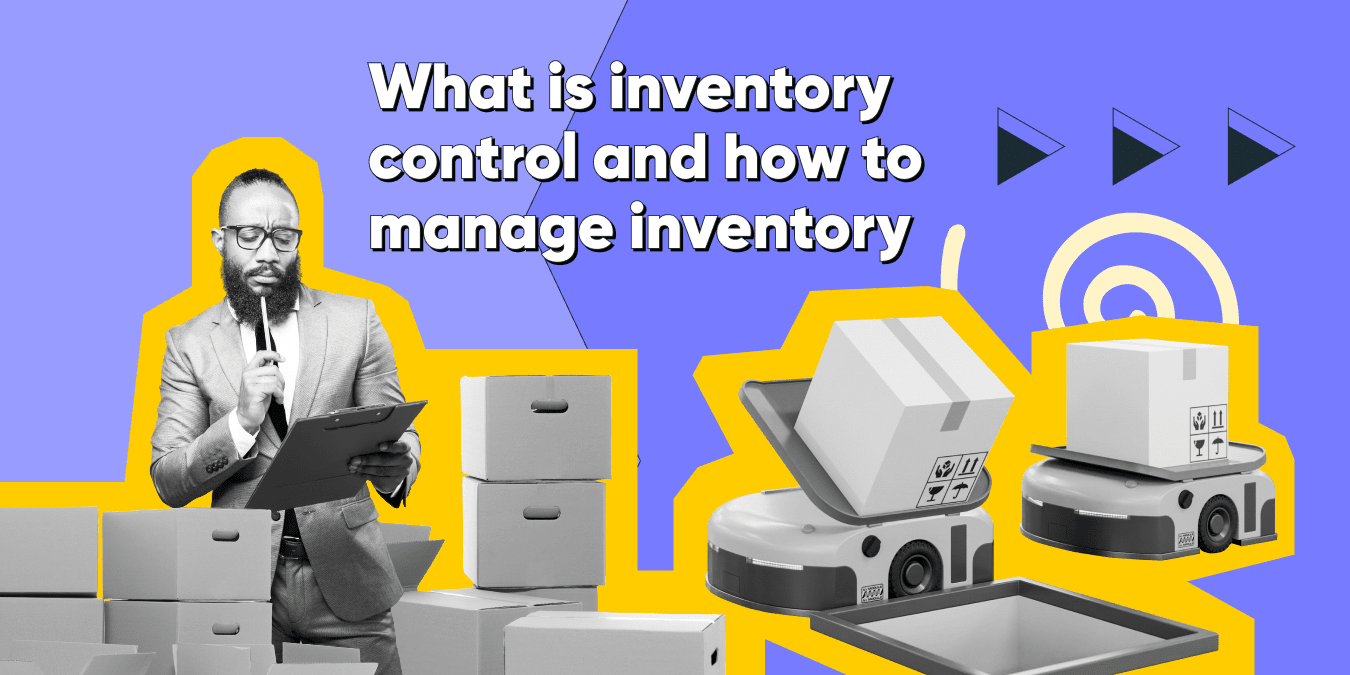
The secrets behind inventory control: The top-performing techniques, working solutions, and best practices that will let you make the most of your stock
Inventory management system and inventory control are the basic terms for supply chain professionals as they apply them at any inventory-related stage within their supply chain process. This article will cover techniques, methods, examples, and solutions for inventory management and inventory control to keep track of inventory and adjust it as needed.
Inventory Control Definition
There is no secret behind the inventory control meaning: it helps to manage the inventory level — so that you don’t end up with too much or too little product at any given time. It deals with the entire life cycle of each item, which begins when it enters your inventory system and ends when it leaves the facility, either at the end of a sale (ideally to a customer) or on a disposal schedule (not an ideal situation, but it happens).
Simply put, an inventory control system monitors your products’ movement, usage, and storage. For comprehensive solutions, companies like Supply Link USA offer specialized services to streamline these processes.
Inventory Control vs Inventory Management

Although sounding similar, the meaning of inventory control and inventory management definition are different. Inventory controls work with your existing inventory, checking its composition, condition, and location within a warehouse. In its turn, an inventory management system covers business processes related to inventory, including its forecasting and planning. With this approach, you’ll already be able to reorder and purchase items, without out-of-stock or excess inventory situations.
In essence, inventory control is the basis of proper inventory management. You need both approaches to ensure the inventory is located properly, received timely, and comes in the correct quantity.
Inventory Management System Guide
Inventory is an investment, as Amazon states. But a well-controlled inventory maximizes profits and improves the customer experience from your stock investments.
To reach such effectiveness, you need to collect various types of data, related to purchases, reorders, logistics, warehousing, storage, customers, and turnover. Companies set inventory systems into their supply chain management processes to store such data.
Inventory systems lets you track goods within the supply chain to help in governing and maintaining the optimal amount of each category. Once effective, an inventory management system assists in upkeeping purchase orders and functions for supply chains. Also, various forecasting and ordering systems inside such systems can help you identify timely if you need to order again and when exactly.
How Do Inventory Systems Work?
Inventory systems range based on business types and internal processes. The tasks they manage include:
- Barcode scanning
- Inventory counting
- Controlling sales and purchase orders
- Filling product information
- Reporting and editing
Automated Inventory Process Management

Once automated, an inventory management system works faster, streamlining workflows and saving time on performing physical inventories. With automated software, you get the self-managed inventory with optimized processes and can focus on other business-critical tasks. It lets you automate numerous processes, including dropshipping, order fulfillment, invoicing, and customer tagging.
To achieve the best results, you can combine an automated inventory system with manual control over critical processes — like breakage, stolen goods, and product loss. In this case, you can ensure that mistakes, missing items, and improperly scanned items won’t interfere with automated inventory process management. A good practice is to introduce mathematical corrections to the most common errors that are done automatically — this way, you’ll control inventory and won’t need to handle such mistakes manually while relying on the software in your decision-making process.
Utilizing the expertise of a Toronto math tutor can further enhance your team’s ability to apply these mathematical corrections effectively, ensuring precision in your inventory management. This specialized knowledge allows for a more accurate analysis of inventory trends and anomalies, making your automated system more robust against errors.
Multichannel Inventory Management: Best Practices and Benefits
Companies go for inventory management to upgrade their processes and business results. To get started with the software, you should make sure you will get item-level visibility. That’s a must for inventory control and the essential information you’ll work with to improve your business results, like managing special offers, seeing sales figures, and evaluating the speed of your operations.
Here are 4 reasons why your business needs to upgrade to the automated inventory control system:
- Greater flexibility: Managing tons of spreadsheets doesn’t help increase your business’s speed and agility of the inventory process. Once you move your inventory to the cloud, you will get a flexible system that increases your management capacities and lets your employees work faster and easier.
- Better accuracy: Due to fast and efficient auditing, the inventory management system lets you find and track items without spending too much effort. The software brings in better barcodes and label track inventory, eliminates write-offs, and lets you forget about stockouts.
- Cost optimization: The software lets you control inventory, minimize holding costs, and maintain storage efficiently. The more time it saves, the greater increase in profits you can potentially have.
- Growth boost: By providing employees with better tools and built-in analytics for managing stocks, creating reports, and making decisions, you can boost sales and make your business grow faster.
Check out the overviews from the Mass Group and Econsultancy blogs for more benefits of a multichannel inventory management system.
Here are the exact features you can choose from when deciding what’ll be inside your new inventory system:
- Tools for stock control and forecasting stock anomalies
- Automated replenishment calculation
- Lead time management
- Control inventory with safety stock computations
- Cost management
- Multi-location support
- Logical methods to call out expired and slow-moving products
- Back office software integration
- Automatic inventory monitoring
- Automatic batch controls
- Supplier information measurement
- Barcode scanning
- RFID system integration
- Personalized item pricing
- Multi-currency payments
- Per-item and per-category editing
- Multiple warehouse communication
- Quality control metrics
- Batch tracking
- Multi-user support
Inventory management best practices: One thing to remember about any system is that it needs to be built with your future needs in mind and also be open to future technological updates. Even more, the best practice to control inventory with the software is to rely on your current business needs and the strategic vision of your business development. Besides, you can start by adding inventory management extensions to your current eCommerce platform — for instance, see what WooCommerce offers for improving your inventory process.
Inventory Management Solutions: How to Choose?
Manual inventory control is challenging due to many factors: it’s labor-intensive, slow to share, easy to human errors, generates paperwork, and calls for regular examination and validation. With an automatic inventory solution, you can fix all these problems at once.

Nevertheless, advancing your inventory management should be an informed decision. In this section, we’ll describe 4 key factors to consider while shifting from manual work to automated solutions for the inventory process.
1. Product composition
The appearance of inventory management solutions changes depending on the exact products they controls, as the tools for controlling inventory for a clothing brand and a high-end electronics company are different. Clothes have their seasonality and depend on the fashion trends, while electronics require inventory management solutions for safety and in-built analytics to analyze their performance. Such factors determine what’ll be inside the stock control system for a particular business.
2. System integration
You can decide on inventory control to be integrated with other existing systems in your computing environment for easier scaling in the future. Depending on your choice and particular needs, the price and amount of work required for building an inventory management system differs.
3. Price
Inventory management solutions come at a different price, which is another vital factor to consider. To get the best price for yourself, critically review your business, define the most critical features you need to improve, and only then accommodate your new transition. Rely on ROI calculation while controlling invetory to predict the performance of your solution and understand the wait time before you start receiving profits from your investment.
4. Staffing
Your current staff is the primary judge of inventory management solutions because your employees will work with it daily and see how it works. That’s why setting the time required for staff to transition is among the most critical factors for calculating the software price. A perpetual inventory system can replace low-skilled employees — but it calls for hiring new specialists who can assist in software installation, maintenance, and troubleshooting.
The ideal situation is when all your employees can master working with new software fast. Alternatively, you will need to find new workers specialized in controlling inventory software and reassign people.
Types and Methods of Inventory Control
Based on the approach Netsuite offered, the most common types of inventory systems include
- Spreadsheet to control inventory: As the least expensive option, a good-old spreadsheet is a tool for manual control over your inventory. This system type of controlling inventory will work well with little inventory and simple processes.
- Periodic inventory information system: This time-consuming approach requires you to make some calculations between specific periods of time. The formula to define the cost of goods sold (COGS) is summing up Beginning Inventory and Purchases and taking Closing Inventory from this sum.
- Perpetual inventory system: As the most costly type, this inventory control model provides high-tech solutions for enhanced control. You’ll get real-time updates, advanced visibility, and saved efforts on physical inventory calculations.
As the best-working example of inventory management system, perpetual control software require heavier equipment and software maintenance investments but possesses value for money. With such inventory management solutions, you can rely on algorithms based on sales and purchases and control inventory accounting at any time. This will save you time and effort in getting an accurate overview of your products at any time — without the need to control this information manually.
Methods of Inventory Control
Inventory control methods unite formulas, forecasting techniques, and approaches that investigate the advantages and operations within your supply chain and provide you with exact calculations on the items to maintain, sell, and purchase. The end goal of applying methods of inventory control is to maintain the equality between your expenses and customer needs — so you don’t buy too much and don’t have too little to sell to customers.
Here are the calculations and management methods applied to inventory control:
- Days of inventory outstanding (DIO): Calculates the days your company holds stock before it meets its buyers. The lower you keep your DIO, the better for you. If you’re a startup and your DIO suddenly increases, it means that you’ve started applying poor inventory control practices.
- Minimum order quantity (MOQ): Determines the smallest amount of inventory to lower expenses for retailers. The MOQ value depends on the product cost: the cheaper an item is, the greater its cost-effectiveness.
- Just-in-time inventory management (JIT): A technique to let you receive inventory on an as-needed basis, without risking dead stock. The best way is to combine this method with safety stock inventory management that will determine the amount of extra inventory to order, store safely and use in the case of replenishment.
- Lean manufacturing: A high-level management philosophy that unites several methods of inventory control to improve manufacturing efficiency and minimize the number of useless activities that bring no value to customers. The methodology includes various techniques for schedule visualization to track and eliminate bottlenecks and backlogs.
- Six Sigma: Minimizes error probability with the define, measure, analyze, improve and control (DMAIC) technique. The methodology provides tools to enhance the business performance (like making higher profits) and eliminate stockouts and excess inventory.
- Lean Six Sigma: An advanced version of Six Sigma that concentrates on reducing waste and defects of products. This method lets you see root problems in your inventory management and work on word standardization and business flow.
Inventory Forecasting Best Practices

Forecasting is an important part of inventory control, as it increases your confidence in maintaining your current inventory in an optimal state in the future. Various forecasting techniques can be used to predict demand for a product or service, with each type having its benefits and drawbacks. The best forecasting technique for you will depend on the industry, product mix, time horizon for demand prediction, organization size, and forecasting experience.
For example, an attribute-based forecasting technique might work well if you have many products with differing attributes. In turn, exponential smoothing may work well if you predict demand over the next few weeks or months. A moving average method might work better if you predict demand over the next year or two. You could also use statistical regression analysis to forecast customer response rates based on historical data trends.
The work of inventory management systems always depends on your specific situation. But if you want some general recommendations, here’s the primary sequence of actions the Inventoro blog listed for you:
- Get lead time demand number (Lead time demand = average lead time in days x average daily sales).
- Determine sales trends (increase and decrease of your sales over time)
- Set ROP (ROP = (average daily sales x lead time) + safety stock)
- Calculate safety stock (Safety stock = (maximum daily sales x maximum lead time in days) – (average daily sales x average lead time in days))
Methods and Formulas to Forecast Inventory
We recommend relying on mathematical formulas within inventory management systems instead of manual methods to eliminate the possibility of a human mistake and enlarge the set of variables in your analysis:
- ABC control: This method helps you manage your inventory by dividing it into three categories. The “A” group stands for expensive items that are sold slowly. “B” items have moderate value and are moderately popular among buyers. “C” items are of low value but sold fast. With this categorization, you can prioritize your attention to your inventory, letting “C” products have constant turnover and working on “A” and “B” categories to increase the frequency of their sales. The ABC method lets you foresee your available stock, ensure stock control, and appropriately set storage and packing locations for forecasting.
- Reorder Point (ROP) formula: This calculation gives you an accurate time to order or manufacture more stock. It relies on your current information, meaning summing up your lead time demand and safety stock. Sometimes, you’ll need to reorder the lead time for this formula, meaning the time between order placement and when you actually receive it.
- Economic order quantity (EOD): A formula to determine the required inventory to purchase it timely and eliminate extra holding. EOD applies a set of variables, including total production costs and demand rate, to minimize your expenses on logistics and warehouse needs. However, it’s better for you to conduct manual calculations to polish the predictions on constant demand for a product, quick access to restocking, and possible fluctuations this method may oversee.
Example of Inventory Management
When you work in a manufacturing company, introducing inventory management systems helps you deal with the need to know how much you should produce to meet the demand. The meaning of inventory management is clear here: if you overproduce, you will lose money; if you underproduce, you will lose sales or customers.
In this example of inventory management, to get the right amount produced, you should calculate the desired inventory for your plant that produces goods for consumption at a given time (e.g., the end of October). To put it simply, you should take the number of units consumed by all the different plants in that time period and divide it by the amount of production in those plants in that same time period. In practice, the calculations are more sophisticated and include factors of seasonality, categorization of your production, peculiarities of various sales channels, etc.
The result of applying inventory management systems and methods gives you the desired inventory level for each plant. Once these numbers are calculated in your inventory control systems, you can determine how many units each plant needs to produce daily.
What Is Inventory Tracking? Top Tips for Tracking Inventory
Inventory tracking is the process of keeping track of goods and materials within inventory control management. This can be done manually or through technology, but either way, it’s important to have a system in place to ensure accuracy and efficiency. Tracking inventory ensures you know how much stock you have on hand at any time.
A common type of inventory tracking involves counting items when they come into your store, counting them again when they’re sold, and subtracting the second number from the first. There are also more sophisticated methods that involve using sensors or scanners to keep track of stock levels without having to count each item by hand.
All in all, inventory tracking lets you know how much stock you have on hand so you can plan ahead in inventory management systems.
5 Tips for Tracking Inventory:
- Keep a master list of all inventory items. This should include item descriptions, quantities, locations, and more.
- Update the master list regularly. As items are added or removed from inventory, be sure to update the master list accordingly.
- Use barcodes or RFID tags. These can help automate the inventory tracking process by allowing you to scan items in and out of stock.
- Utilize software or apps. Many software programs make tracking inventory easy, including some allowing you to input product information with just a few clicks. Plus, plenty of free options are available if your budget is tight.
- Take photos and videos. Whenever possible, take photos or videos when restocking shelves or otherwise working with inventory so that the entire process can be documented for future reference if needed.
- Consider investing in an electronic device for counting inventory at different points in the day (such as at night). It may seem like an unnecessary expense at first glance, but this type of device could save time and money down the line by cutting down on manual labor costs while still providing accurate numbers as necessary.
What Is Inventory Planning? Meaning, Challenges & Best Practices

In inventory control management, Inventory planning is the strategic process of ensuring that a company always has the right amount of inventory on hand. The goal is to avoid both stockouts (when items are unavailable for purchase) and excess inventory (which ties up cash flow). Once you’ve applied the formulas for calculating forecasting, you can proceed to the planning stage to get the exact numbers for updating your stock.
Meaning: The goal of inventory planning is to minimize total cost while keeping safety stock (the buffer amount of inventory you have in case it runs out) high enough to avoid stockouts. That means maximizing available cash by reducing excess inventory and minimizing lost sales from out-of-stock items. To do that, you’ll need to figure out how much inventory to order for each product based on projected sales for a particular time period—and then how much excess (or safety) stock to keep in case your estimates are off. For example, if you set aside too little safety stock for an item that runs out in early October but will be restocked before Christmas, you’ve just given up several months of revenue from a significant selling period.
Challenges: The main challenges for inventory planning refer to predicting future demand levels and project sales volumes over specific periods. Certain companies use rules of thumb, others use advanced forecasting models, such as exponential smoothing or neural networks.
Best practices for inventory planning include keeping records of what was ordered and when, so you know when a new order needs to be placed and how long it’s been since an order was placed. Also, allowing employees who work with ordering inventory at specific stores or warehouses some autonomy to make decisions about what needs to be ordered will help ensure they’re providing the right balance between safety stock and excess inventory.
How to Unlock a Multichannel Inventory Control Management from Different eCommerce Platforms?
In this guide, our aim was to give you a detailed answer to the question, “What is inventory control?”. In particular, we’ve conceptualized the inventory control vs. inventory management difference, showed the exact tips and tricks to strengthen your stock control, and explained the possible methods, types, and activities done under inventory control management processes. The only thing left is to determine your exact business need for controlling inventory — and find the software type that will cover it fully and offer the features that address your future demands.
And if you’re searching for ways to get rid of manual eSelling, Sellbery is the right tool for you.
Sellbery will help you with managing and controlling inventory in terms of product information management. Our software will help you manage your stocks on Amazon, eBay, Etsy, WooCommerce and Shopify with ease. With our inventory control management tool, you will get multichannel product management, be able to sync stock quantities and warehouse products, improve your order management, and manage multichannel product listing faster. And even more — you can try us for free!
Was this news helpful?







 Yes, great stuff!
Yes, great stuff! I’m not sure
I’m not sure No, doesn’t relate
No, doesn’t relate



